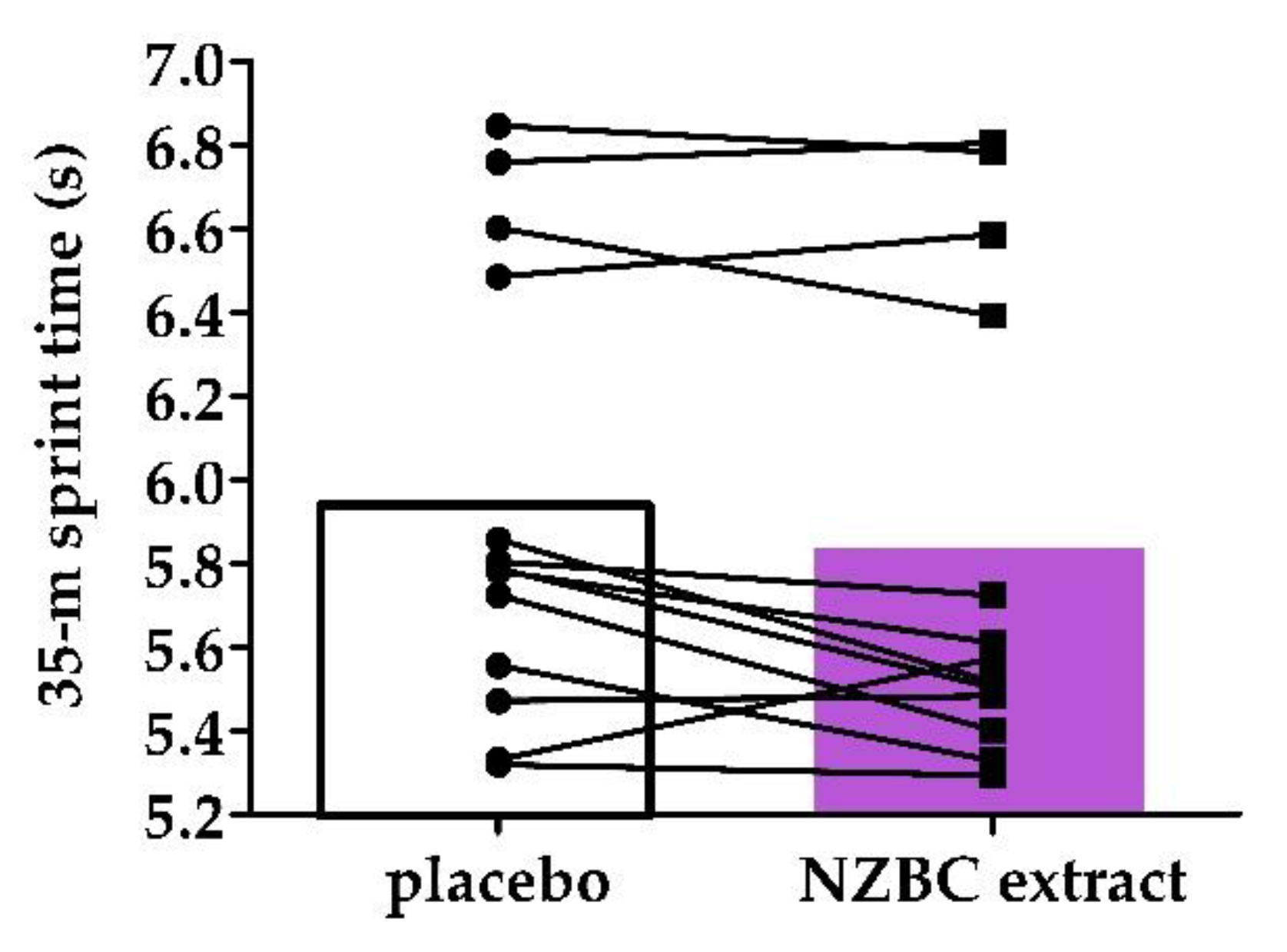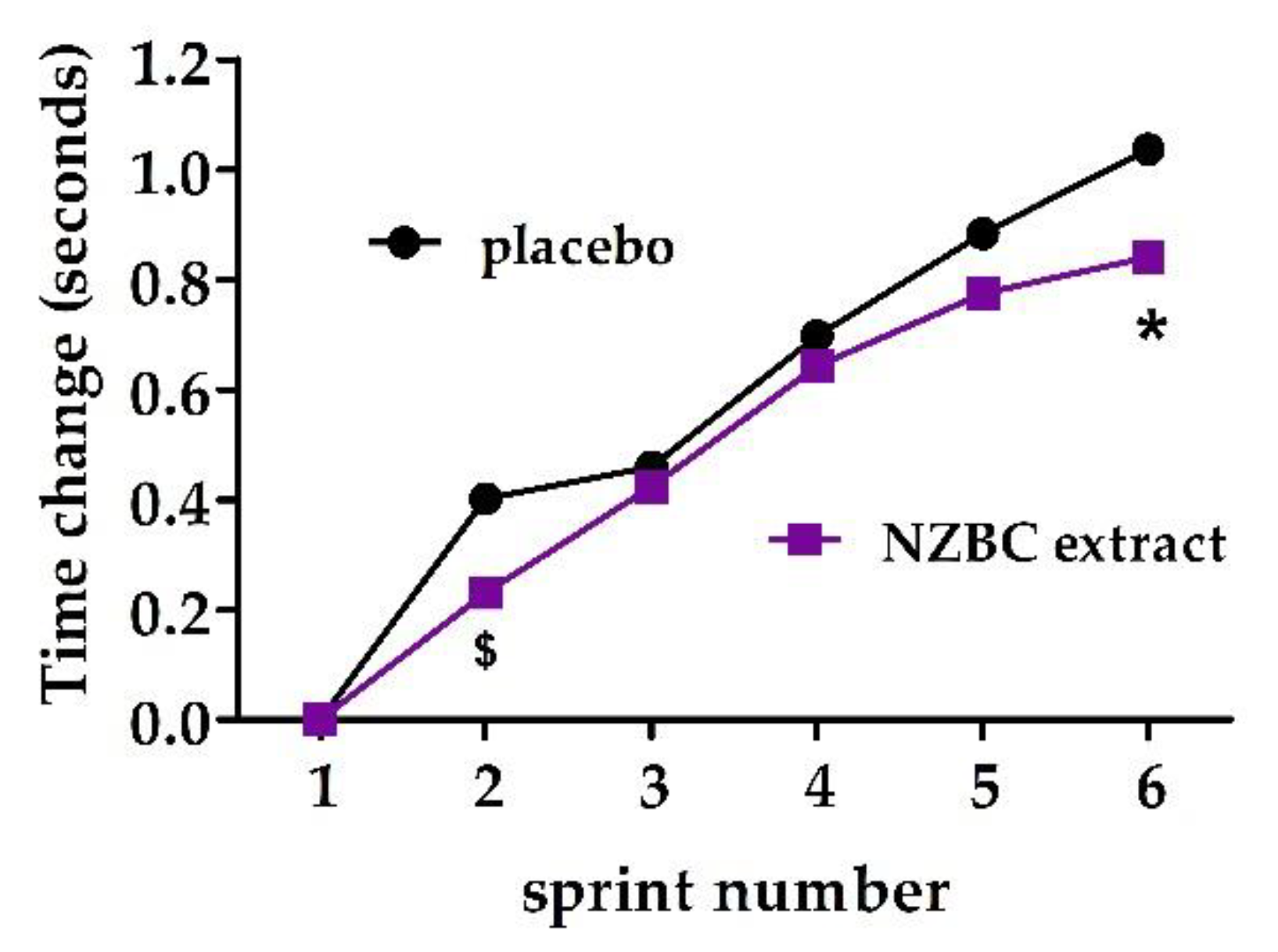Effects of New Zealand Blackcurrant Extract on Sequential Performance Testing in Male Rugby Union Players
Abstract
1. Introduction
2. Materials and Methods
2.1. Participants and Ethical Approval
2.2. Experimental Design
2.3. Supplementation
2.4. Running-Based Anaerobic Sprint Test (RAST)
2.5. The Illinois Agility Test
2.6. Seated Medicine Ball Throw Test
2.7. Handgrip Strength
2.8. Data and Statistical Analysis
3. Results
3.1. Running-Based Anaerobic Sprint Test
3.1.1. Fastest 35 m Sprint
3.1.2. Mean 35 m Sprints and Individual Changes
3.1.3. Change in Sprint Performance Compared to Sprint 1
3.2. Illinois Agility Test
3.3. Seated Medicine Ball Throw Test
3.4. Handgrip Strength
3.5. Blinding Assessment
4. Discussion
5. Conclusions
Author Contributions
Funding
Institutional Review Board Statement
Informed Consent Statement
Data Availability Statement
Acknowledgments
Conflicts of Interest
References
- Austin, D.; Gabbett, T.; Jenkins, D. Repeated high-intensity exercise in professional rugby union. J. Sports Sci. 2011, 29, 1105–1112. [Google Scholar] [CrossRef]
- Jarvis, S.; Sullivan, L.O.; Davies, B.; Wiltshire, H.; Baker, J.S. Interrelationships between Measured Running Intensities and Agility Performance in Subelite Rugby Union Players. Res. Sports Med. 2009, 17, 217–230. [Google Scholar] [CrossRef] [PubMed]
- Gannon, E.A.; Stokes, K.; Trewartha, G. Strength and Power Development in Professional Rugby Union Players Over a Training and Playing Season. Int. J. Sports Physiol. Perform. 2016, 11, 381–387. [Google Scholar] [CrossRef]
- Owen, C.; Till, K.; Weakley, J.; Jones, B. Testing methods and physical qualities of male age grade rugby union players: A systematic review. PLoS ONE 2020, 15, e0233796. [Google Scholar] [CrossRef]
- Sayers, M.G.L.; Washington-King, J. Characteristics of effective ball carries in Super 12 rugby. Int. J. Perform. Anal. Sport 2005, 5, 92–106. [Google Scholar] [CrossRef]
- Wheeler, K.W.; Askew, C.D.; Sayers, M.G. Effective attacking strategies in rugby union. Eur. J. Sport Sci. 2010, 10, 237–242. [Google Scholar] [CrossRef]
- Gabbett, T.J.; Jenkins, D.G.; Abernethy, B. Physiological and Anthropometric Correlates of Tackling Ability in Junior Elite and Subelite Rugby League Players. J. Strength Cond. Res. 2010, 24, 2989–2995. [Google Scholar] [CrossRef]
- Smart, D.; Hopkins, W.G.; Quarrie, K.L.; Gill, N. The relationship between physical fitness and game behaviours in rugby union players. Eur. J. Sport Sci. 2011, 14 (Suppl. 1), S8–S17. [Google Scholar] [CrossRef]
- Ball, S.; Halaki, M.; Sharp, T.; Orr, R. Injury Patterns, Physiological Profile, and Performance in University Rugby Union. Int. J. Sports Physiol. Perform. 2018, 13, 69–74. [Google Scholar] [CrossRef]
- Crang, Z.L.; Hewitt, A.; Scott, T.J.; Kelly, V.G.; Johnston, R.D. Relationship between Preseason Training Load, Match Performance, and Match Activities in Professional Rugby League. J. Strength Cond. Res. 2020, 36, 2581–2588. [Google Scholar] [CrossRef] [PubMed]
- Calleja-González, J.; Mielgo-Ayuso, J.; Ostojic, S.M.; Jones, M.T.; Marques-Jiménez, D.; Caparros, T.; Terrados, N. Evidence-based post-exercise recovery strategies in rugby: A narrative review. Physician Sportsmed. 2018, 47, 137–147. [Google Scholar] [CrossRef]
- Braakhuis, A.J.; Somerville, V.X.; Hurst, R.D. The effect of New Zealand blackcurrant on sport performance and related biomarkers: A systematic review and meta-analysis. J. Int. Soc. Sports Nutr. 2020, 17, 25. [Google Scholar] [CrossRef]
- Willems, M.E.T.; Blacker, S.D. Anthocyanin-Rich Supplementation: Emerging Evidence of Strong Potential for Sport and Exercise Nutrition. Front. Nutr. 2022, 9, 864323. [Google Scholar] [CrossRef]
- Perkins, I.C.; Vine, S.A.; Blacker, S.D.; Willems, M. New Zealand Blackcurrant Extract Improves High-Intensity Intermittent Running. Int. J. Sport Nutr. Exerc. Metab. 2015, 25, 487–493. [Google Scholar] [CrossRef]
- Godwin, C.; Cook, M.D.; Willems, M.E.T. Effect of New Zealand Blackcurrant Extract on Performance during the Running Based Anaerobic Sprint Test in Trained Youth and Recreationally Active Male Football Players. Sports 2017, 5, 69. [Google Scholar] [CrossRef]
- Monks, M.R.; Compton, C.T.; Yetman, J.D.; Power, K.E.; Button, D.C. Repeated sprint ability but not neuromuscular fatigue is dependent on short versus long duration recovery time between sprints in healthy males. J. Sci. Med. Sport 2017, 20, 600–605. [Google Scholar] [CrossRef]
- Neveu, V.; Pérez-Jiménez, J.; Vos, F.; Crespy, V.; du Chaffaut, L.; Mennen, L.; Knox, C.; Eisner, R.; Cruz, J.; Wishart, D.; et al. Phenol-Explorer: An online comprehensive database on polyphenol contents in foods. Database 2010, 2010, bap024. [Google Scholar] [CrossRef]
- Fletcher, I.M.; Jones, B. The Effect of Different Warm-up Stretch Protocols on 20 Meter Sprint Performance in Trained Rugby Union Players. J. Strength Cond. Res. 2004, 18, 885–888. [Google Scholar] [CrossRef]
- Cook, M.D.; Myers, S.D.; Gault, M.L.; Willems, M.E.T. Blackcurrant Alters Physiological Responses and Femoral Artery Diameter during Sustained Isometric Contraction. Nutrients 2017, 9, 556. [Google Scholar] [CrossRef]
- Strauss, J.A.; Willems, M.E.T.; Shepherd, S.O. New Zealand blackcurrant extract enhances fat oxidation during prolonged cycling in endurance-trained females. Eur. J. Appl. Physiol. 2018, 118, 1265–1272. [Google Scholar] [CrossRef]
- Montanari, S.; Şahin, M.A.; Lee, B.J.; Blacker, S.D.; Willems, M.E.T. No Effects of New Zealand Blackcurrant Extract on Physi-ological Responses in Trained Male Cyclists Undertaking Repeated Testing across a Week Period. Sports 2020, 8, 114. [Google Scholar] [CrossRef]
- Zagatto, A.M.; Beck, W.R.; Gobatto, C.A. Validity of the Running Anaerobic Sprint Test for Assessing Anaerobic Power and Predicting Short-Distance Performances. J. Strength Cond. Res. 2009, 23, 1820–1827. [Google Scholar] [CrossRef]
- Hachana, Y.; Chaabene, H.; Nabli, M.A.; Attia, A.; Moualhi, J.; Farhat, N.; Elloumi, M. Test-Retest Reliability, Criterion-Related Validity, and Minimal Detectable Change of the Illinois Agility Test in Male Team Sport Athletes. J. Strength Cond. Res. 2013, 27, 2752–2759. [Google Scholar] [CrossRef]
- Raya, M.A.; Gailey, R.S.; Gaunaurd, I.A.; Jayne, D.M.; Campbell, S.M.; Gagne, E.; Manrique, P.G.; Muller, D.G.; Tucker, C. Comparison of three agility tests with male servicemembers: Edgren Side Step Test, T-Test, and Illinois Agility Test. J. Rehabil. Res. Dev. 2013, 50, 951–960. [Google Scholar] [CrossRef]
- Beckham, G.; Lish, S.; Keebler, L.; Longaker, C.; Disney, C.; DeBeliso, M.; Adams, K.J. The Reliability of the Seated Medicine Ball Throw for Distance. J. Phys. Act. Res. 2019, 4, 131–136. [Google Scholar] [CrossRef]
- Quarrie, K.L.; Wilson, B.D. Force production in the rugby union scrum. J. Sports Sci. 2000, 18, 237–246. [Google Scholar] [CrossRef]
- Willems, M.E.; Cousins, L.; Williams, D.; Blacker, S.D. Beneficial Effects of New Zealand Blackcurrant Extract on Maximal Sprint Speed during the Loughborough Intermittent Shuttle Test. Sports 2016, 4, 42. [Google Scholar] [CrossRef]
- Curran-Everett, D.; Benos, D.J. Guidelines for reporting statistics in journals published by the American Physiological Society. Am. J. Physiol. Endocrinol. Metab. 2004, 287, E189–E191. [Google Scholar] [CrossRef]
- Girard, O.; Mendez-Villanueva, A.; Bishop, D. Repeated-Sprint Ability—Part I.: Factors contributing to fatigue. Sports Med. 2011, 41, 673–694. [Google Scholar] [CrossRef]
- Spencer, M.; Bishop, D.; Dawson, B.; Goodman, C. Physiological and Metabolic Responses of Repeated-Sprint Activities: Specific to field-based team sports. Sports Med. 2005, 35, 1025–1044. [Google Scholar] [CrossRef]
- McKenna, M.J.; Medved, I.; Goodman, C.A.; Brown, M.J.; Bjorksten, A.R.; Murphy, K.T.; Petersen, A.C.; Sostaric, S.; Gong, X. N-acetylcysteine attenuates the decline in muscle Na+, K+-pump activity and delays fatigue during prolonged exercise in humans. J. Physiol. 2006, 576 Pt 1, 279–288. [Google Scholar] [CrossRef]
- Pedersen, T.H.; Nielsen, O.B.; Lamb, G.D.; Stephenson, D.G. Intracellular Acidosis Enhances the Excitability of Working Muscle. Science 2004, 305, 1144–1147. [Google Scholar] [CrossRef]
- Potter, J.A.; Hodgson, C.I.; Broadhurst, M.; Howell, L.; Gilbert, J.; Willems, M.E.T.; Perkins, I.C. Effects of New Zealand blackcurrant extract on sport climbing performance. Eur. J. Appl. Physiol. 2019, 120, 67–75. [Google Scholar] [CrossRef]
- Gibson, N.; Baker, D.; Sharples, A.; Braakhuis, A. Improving Mental Performance in an Athletic Population with the Use of Ārepa®, a Blackcurrant Based Nootropic Drink: A Randomized Control Trial. Antioxidants 2020, 9, 316. [Google Scholar] [CrossRef]
- Watson, A.W.; Haskell-Ramsay, C.F.; Kennedy, D.; Cooney, J.M.; Trower, T.; Scheepens, A. Acute supplementation with blackcurrant extracts modulates cognitive functioning and inhibits monoamine oxidase-B in healthy young adults. J. Funct. Foods 2005, 17, 524–539. [Google Scholar] [CrossRef]
- Cho, H.-U.; Kim, S.; Sim, J.; Yang, S.; An, H.; Nam, M.-H.; Jang, D.-P.; Lee, C.J. Redefining differential roles of MAO-A in dopamine degradation and MAO-B in tonic GABA synthesis. Exp. Mol. Med. 2021, 53, 1148–1158. [Google Scholar] [CrossRef]
- Saul, M.C.; Majdak, P.; Perez, S.; Reilly, M.; Garland, T., Jr.; Rhodes, J.S. High motivation for exercise is associated with altered chromatin regulators of monamine receptor gene expression in the striatum of selectively bred mice. Genes Brain Behav. 2017, 16, 328–341. [Google Scholar] [CrossRef]
- Roberts, S.P.; Trewartha, G.; Higgitt, R.J.; El-Abd, J.; Stokes, K. The physical demands of elite English rugby union. J. Sports Sci. 2008, 26, 825–833. [Google Scholar] [CrossRef]
- Green, A.; Kerr, S.; Olivier, B.; Meiring, R.; Dafkin, C.; McKinon, W. A simulated rugby match protocol induces physiological fatigue without decreased individual scrummaging performance. S. Afr. J. Sports Med. 2017, 29, 1–6. [Google Scholar] [CrossRef]
- Willems, M.E.T.; Banic, M.; Cadden, R.; Barnett, L. Enhanced Walking-Induced Fat Oxidation by New Zealand Blackcurrant Extract Is Body Composition-Dependent in Recreationally Active Adult Females. Nutrients 2022, 14, 1475. [Google Scholar] [CrossRef]


Publisher’s Note: MDPI stays neutral with regard to jurisdictional claims in published maps and institutional affiliations. |
© 2022 by the authors. Licensee MDPI, Basel, Switzerland. This article is an open access article distributed under the terms and conditions of the Creative Commons Attribution (CC BY) license (https://creativecommons.org/licenses/by/4.0/).
Share and Cite
Burnett, P.J.M.; Willems, M.E.T. Effects of New Zealand Blackcurrant Extract on Sequential Performance Testing in Male Rugby Union Players. Sports 2022, 10, 152. https://doi.org/10.3390/sports10100152
Burnett PJM, Willems MET. Effects of New Zealand Blackcurrant Extract on Sequential Performance Testing in Male Rugby Union Players. Sports. 2022; 10(10):152. https://doi.org/10.3390/sports10100152
Chicago/Turabian StyleBurnett, Patrick J. M., and Mark E. T. Willems. 2022. "Effects of New Zealand Blackcurrant Extract on Sequential Performance Testing in Male Rugby Union Players" Sports 10, no. 10: 152. https://doi.org/10.3390/sports10100152
APA StyleBurnett, P. J. M., & Willems, M. E. T. (2022). Effects of New Zealand Blackcurrant Extract on Sequential Performance Testing in Male Rugby Union Players. Sports, 10(10), 152. https://doi.org/10.3390/sports10100152





